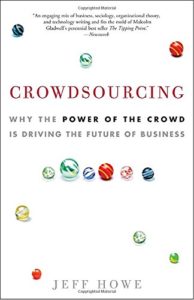
A larger number of people will always have more knowledge about any given problem than any single individual, and therefore offer a greater probability of finding a better solution, as long as two key qualifying conditions are met: 1. There must be sufficient diversity in the group, and 2. Individuals in the group must be thinking and working independently (to avoid the aforementioned groupthink). If these key qualifying conditions are not met, then it is likely that the crowd will produce sub-par results, or even devolve as described by darker books like Crowds and Power by Elias Canetti and Carol Stewart, or The Crowd: A Study of the Popular Mind, by Gustave Le Bon. An additional difference is exactly how the word “crowd” is defined, and Crowdsourcing uses the word in a way that is a bit different from the traditional use of the word.
This Crowdsourcing idea is sort of the human capital analogy to the “law of large numbers” in statistics and probability, in that a greater sample size will produce more accurate results, with another caveat: that the best answer gets recognized out of the crowd. According to Crowdsourcing, this latter problem can also be solved through technology mediated crowd filtering such as online rating and voting systems. In other words, the crowd itself is the best way to assess the products of the crowd.
In a very real way, the idea that large numbers of individuals acting independently can produce better results than a smaller number of centralized planners, is THE fundamental idea of free market economics. History is filled with examples of failures of centralized planning, and with examples of DEcentralized spontaneous organization producing superior results. Since no one person has all information, nor does anyone have a monopoly on good ideas, it becomes evident that many individuals working independently or with various degrees of cooperation and competition can produce better results from the “bottom up” than can a smaller number of people in the form of imposed “top down” solutions.
Crowdsourcing also points out another great idea that may be partly counterintuitive: while sometimes the people closest to a problem may be the best people to solve it, in other cases the people who can come up with the best solutions to a problem are people who have no formal knowledge or training in a specific area. This could partly be attributed to innate ability, but more often can be attributed to the fact that “amateurs” (in Crowdsourcing vernacular) often approach problems from fresh perspectives because they have never been taught that “it can’t be done that way,” and because they may have different thinking skill sets and approaches to solving problems than the “experts” (who often tend to think alike). Sometimes the “amateur” can greatly outperform the “expert” because the thinking of “experts” is at significant risk of getting stuck in a rut regarding how to do something. One example the author uses is how a team of chemists at multinational conglomerate Procter & Gamble could not solve a product packaging problem, while an individual physics professor in Canada did.
As a business person, one of my favorite parts of this book was the discussion about transparency of businesses and opening up more to input from the public. To me this idea was common sense, because as a consumer, I want to have insight into the quality and production practices of the products I buy. And the only way to get that is to have some transparency into the companies I do business with. Or to state it another way, transparency helps to ensure not only product quality, but also the operational integrity of a company. When a company is NOT transparent, that tends to raise the question of “what do they have to hide?”. Unfortunately, most large corporations do not (currently at least) hold transparency (and the integrity that usually goes with it) as a high priority.
That was actually a large part of the reason why we felt the need to start our own business. We just couldn’t find personal care products that were transparent about being truly safe and healthy. Similarly, it was not clear to us that many companies have the level of integrity and transparency that we desired, by being honest in what was put into their products. We got so frustrated that we couldn’t find products we could trust, so Tober and I made our own, which turned into a business by accident. However we decided to be different from everyone else, by being truly honest and transparent. It is true that not everyone will like our products. But those who want safe, quality products, and transparency and integrity, see what we have to offer and are return customers. In the long run that will win over more hearts and minds than any of the silly marketing gimmicks that the big companies rely on.
As a side note, at Nature’s Complement, we prefer win-win solutions and strive to achieve them whenever possible. Similarly, we always greatly value customer feedback. If there is something you like or don’t like, please let us know. If you have ideas or suggestions on how we can improve our products or customer service, please let us know. We will always consider your input, even if we don’t utilize it in the final decision. Feedback is a crucial ingredient in improvement, and indeed, without feedback, improvement is not possible. So please keep the feedback coming, so we can become the best company possible.
I would recommend this book to anyone who works in business, or to any consumer. This book will help businesses not only improve customer relations, but will also help to teach businesses how to better serve their customers. As the author points out: who better to give input on product design than the people who will use the product?
From the consumer side, this book will not only help you become more savvy in how you deal with the companies you do business with, but it will also help you to understand how you can improve the products and services you use, by providing valuable feedback to businesses – at least the ones willing to listen. All it may cost you in the short term is a little time, but can have many benefits in the long run.
If handled correctly (and surely it can be screwed up, even with the best of intentions), this approach is a win-win for both businesses and consumers. In fact, this book argues to a certain degree that networked information technology is causing the lines between producer and consumer to blur, and points out that historically it was the norm for that distinction to be blurred. It is only relatively recently (the last 100 years) that such a sharp distinction between producers and consumers has emerged. To use an analogy, the way things have been in the recent past is like a person passively listening to some pre-recorded music; meanwhile, where things are headed is more like the interaction between a performing musician and the audience at a live show.
A must read for any entrepreneur who understands that today’s business world is vastly different from yesterday’s, and that consumers have a lot more power to choose. And they WILL choose what THEY want, based upon their own values, not what is shoved down their throats by manipulative marketing. This is something that we at Nature’s Complement have been aware of from the minute we started the business, because it began based on real consumer need, not manipulative marketing. Additionally, we are happy to be able to say that we have unintentionally followed the suggestions of this book, before we even read it.
For Health,
Rob
Nature's Complement is a participant in the Amazon Services LLC Associates Program, an affiliate advertising program. If you purchase products on Amazon through any of our affiliate links, we get a small percentage of the transaction, at no extra cost to you. We spend a lot of time writing the articles on this site, and all this information is provided free of charge. When you use our affiliate links, you support the writing you enjoy without necessarily buying our products. (However we would appreciate if you would do that too!) Thank you for helping to support our work, however you choose to do so.
These statements have not been evaluated by the Food and Drug Administration. This information and/or products are not intended to diagnose, treat, cure or prevent any disease.


